Guatemala Birding & Photography Tour at Patrocinio Nature Reserve
The Route to the Reserve
On Thursday, June 12, we headed for a Guatemala Birding & Photography Tour to the province of Retalhuleu.
We headed to the Municipality of El Palmar, in the department of Quetzaltenango; our final destination: was La Reserva Natural Patrocinio.
We left from La Antigua Guatemala, and took the scenic route from the colonial city through El Rodeo, and Escuintla.
This road offers spectacular scenery, especially since the road passes through the volcanic chain in front of the active Fuego volcano and its dormant twin, Acatenango.
Following the CA2 highway, we headed to Retalhuleu, where we took a secondary paved road. It is very difficult to get lost.
When we reached the crossroads where the Hotel and restaurant Siboney are located, there is a sign that leads you to the next intersection through a dirt road on the right side of the road.
Then we reached the reserve, the road was enjoyable, and we found ourselves surrounded by different crops.
We traveled 172 kilometers in approximately three and a half hours.
Wwe must consider that the passage through Cuyotenango is sometimes complicated and can take more time than expected to cross; this time, we were lucky.
When you arrive at the reserve, you immediately find yourself surrounded by crops, the forest, and lovely people.
Immediately before going to our rooms, we went to the restaurant area.
The views are impressive towards the woods. In the distance, the volcanoes, the most significant El Santa María, serve as a frame for a small but very active Santiaguito volcano.

The Lodge at Patrocinio Reserve
The reserve has a lodge surrounded by different crops that attract birds and wildlife species that inhabit this part of the country’s area.
The lodge is divided into: Casa Patronal, Casa Del Bosque Santiaguito, Room del Bosque Patrocinio, Casa Campesina, and an area for Camping.
The restaurant area is open and has feeders for birds; the birds are familiar with the presence of people and present a fantastic photo opportunity.
The reserve is a family property with an extension of approximately 140 hectares.
The land distributed in forests and agricultural areas dedicated to producing coffee, macadamia, mangosteen, avocado, cocoa, among other crops.
We arrived around noon, checked in, and then we headed to the restaurant for our respective lunch.
While we waited for our food, the Yellow-winged Tanager (Thraupis abbas) and the Blue-grey Tanager (Thraupis episcopus) were there giving us a show.
Guatemala Birding & Photography Tour
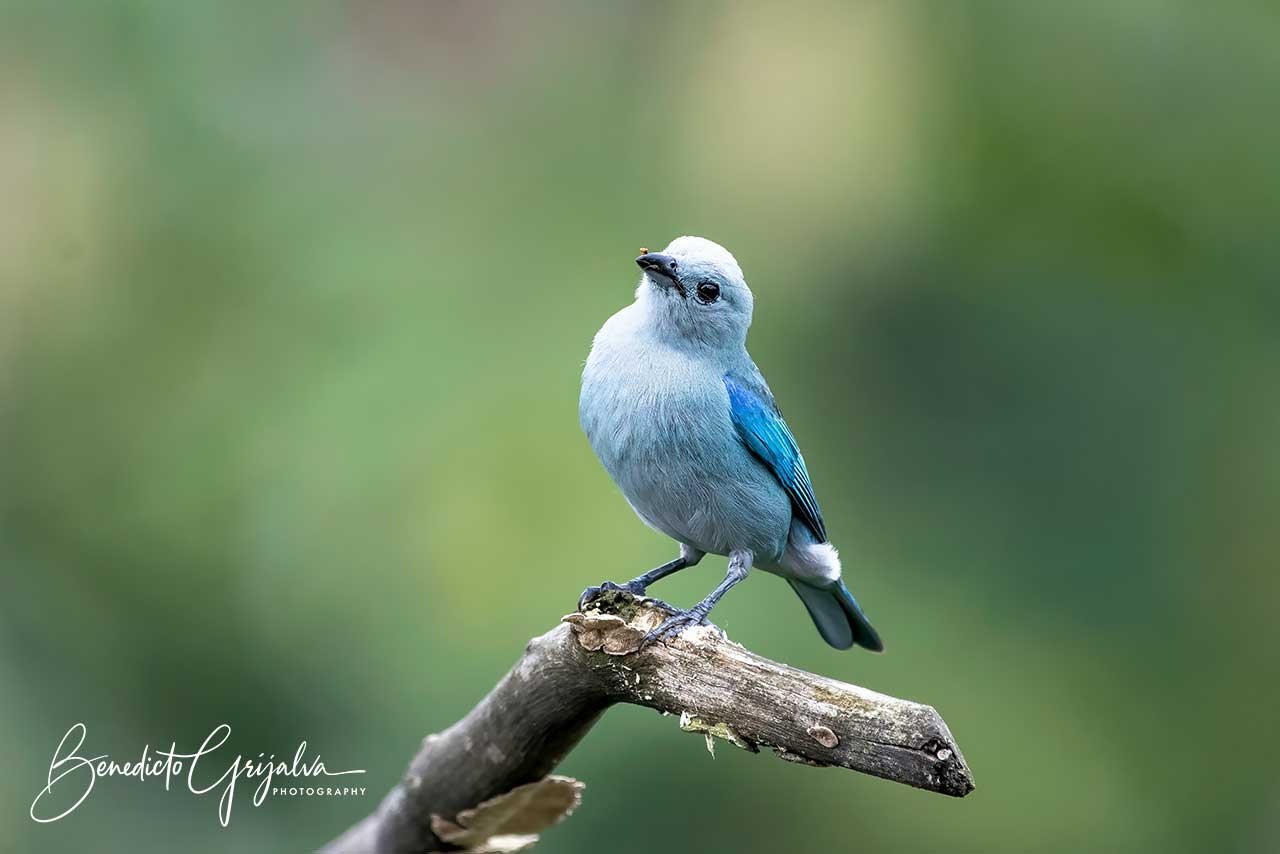
Blue-gray Tanager (Thraupis episcopus)
The Yellow-winged traveled towards the interior ceiling transporting material to build their nest; the Clay-colored Thrush (Turdus grayi) did the same.

Yellow-winged Tanager (Thraupis abbas)
The White-bellied Chachalaca (Ortalis leucogastra) disputed the space at a close distance in the Cecropias.
More species appeared, among them the Rufous-naped Wren (Campylorhynchus rufinucha), the Collared Aracari (Pteroglossus torquatus), and the Masked Tityra (Tityra semifasciata).
The gardens of Verbenaceae and heliconias were the favorites of the Cinnamon Hummingbirds (Amazilia rutila).
They vied for space against some daring Violet Sabrewing (Campylopterus hemileucurus), Blue-tailed Hummingbird (Saucerottia cyanura), and Canivet’s Emerald (Cynanthus canivetii).
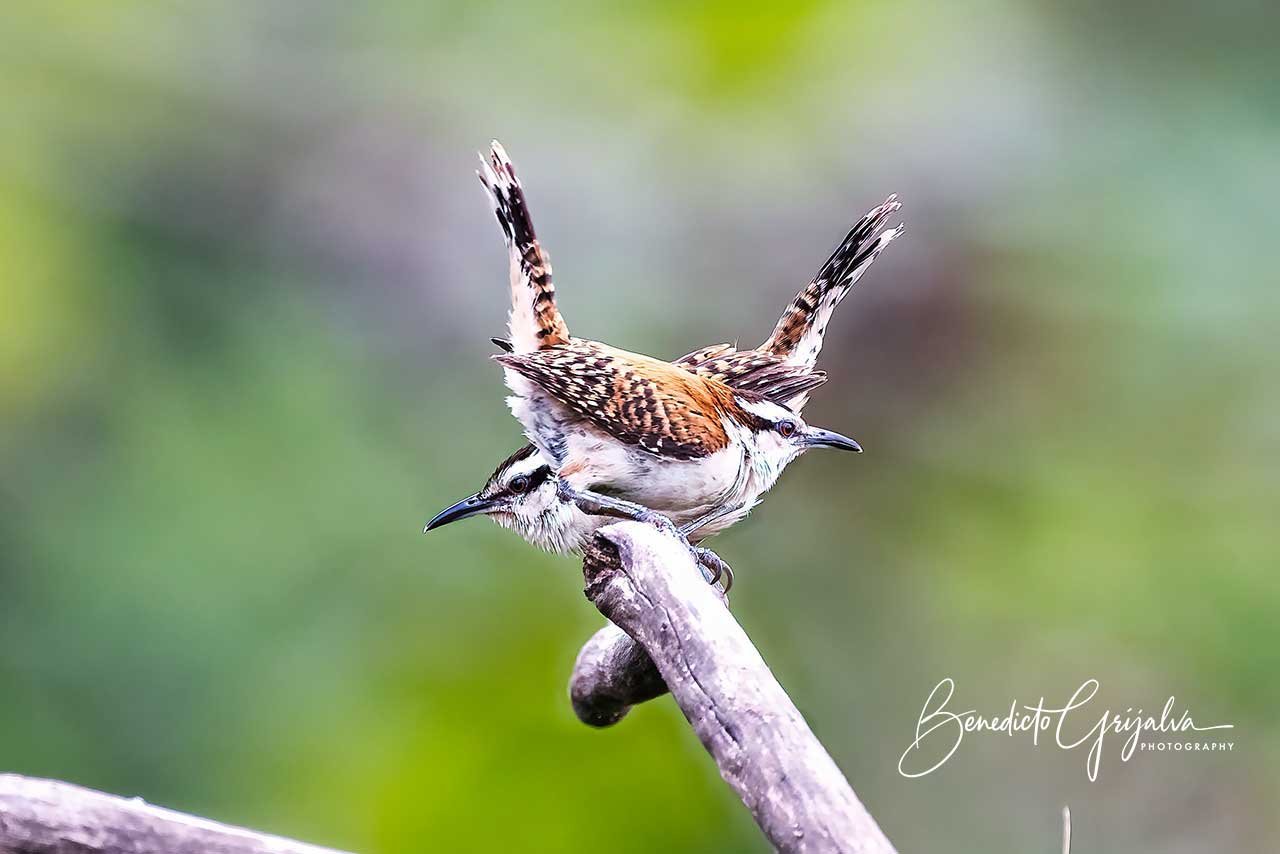
Rufous-naped Wren (Campylorhynchus rufinucha)
After lunch, we decided to explore the trail that leads into the woods located at the back of the room.
The pacific parakeets were the first to appear feeding in the Teak trees.
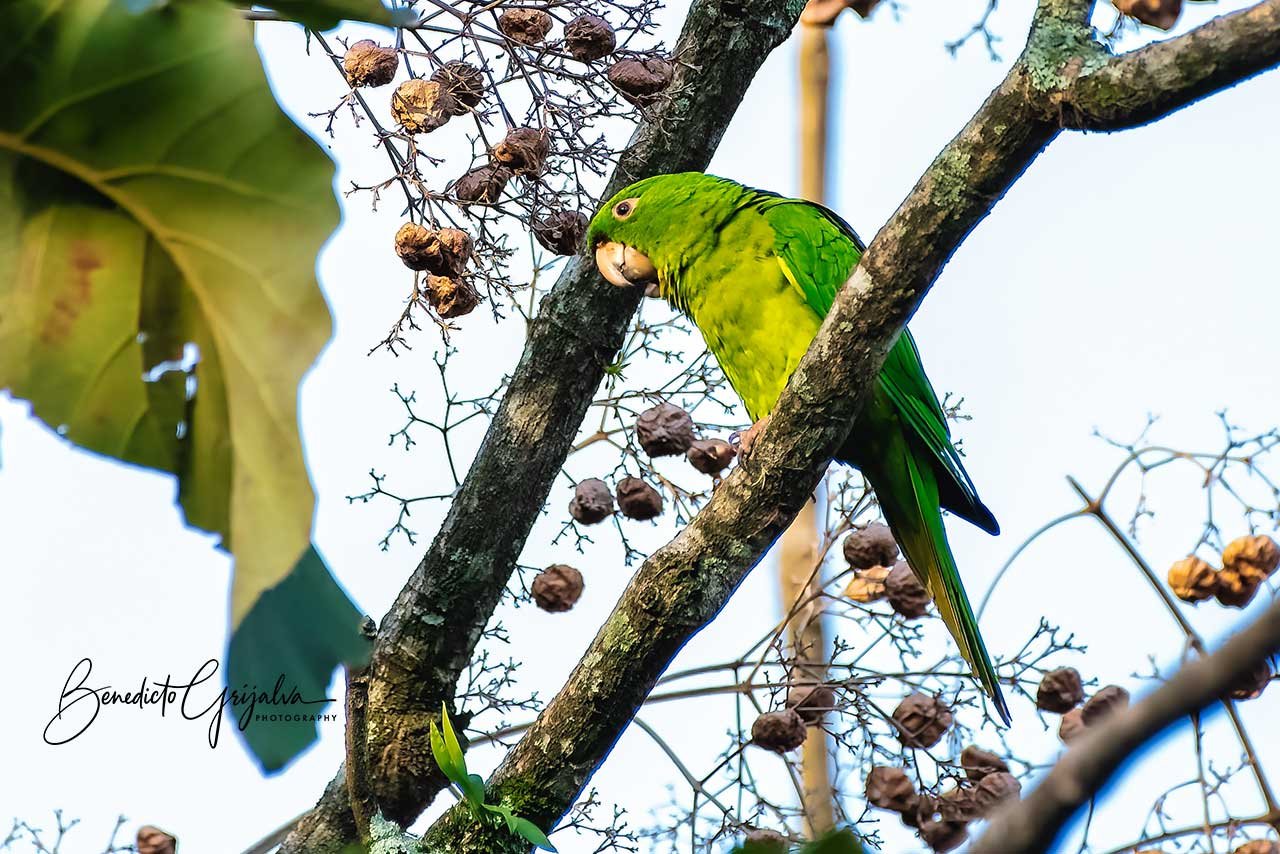
Pacific Parakeet (Psittacara strenuus)
Entering the forest, about 200 meters between the forest and the bamboo area, we began to hear the call of the Long-tailed Manakin (Chiroxiphia linearis).
A few meters ahead, an adult and a youth gave us a few seconds to observe them. I was able to take some pictures.
The butterflies were also participants on the walk. Among them was a Common Morpho Butterfly (Morpho peleides) that quickly disappeared, leaving us the blue of its wings in our memory.
The trail is straightforward to walk most of it is flat with only one slope that can be easily walked.
Then, finally, we reached a more open area where the forest disappears, and the coffee-growing area begins.

Long-tailed Manakin (Chiroxiphia linearis)
Here the few trees inside the coffee plantation served as a perch and feeding area for species such as pairs of Red-legged Honeycreeper (Cyanerpes cyaneus), Masked Tityra (Tityra semifasciata), and Olive-sided Flycatcher (Contopus cooperi).
We spotted a Long-billed Starthroat (Heliomaster longirostris) that moved through the treetops.
Aalso a Tropical Pewee (Contopus cinereus), a pair of Yellow-faced Grassquit (Tiaris olivaceus), and Golden-fronted Woodpecker (Melanerpes aurifrons), among others.

Red-legged Honeycreeper (Cyanerpes cyaneus)
During the return, which we did by the same route, we found a Sulphur-bellied Flycatcher (Myiodynastes luteiventris).
A fascinating bird that migrates from the south to the north where it comes to reproduce and then returns to the south.
Throughout dinner, the calls of a Mottled Owl (Ciccaba virgata) and Barn Owl (Tyto alba) could be heard in the distance.
Finally, a Collared Forest-Falcon (Micrastur semitorquatus) said goodbye to the day with its call.
That was our first day at the Patrocinio Reserve.
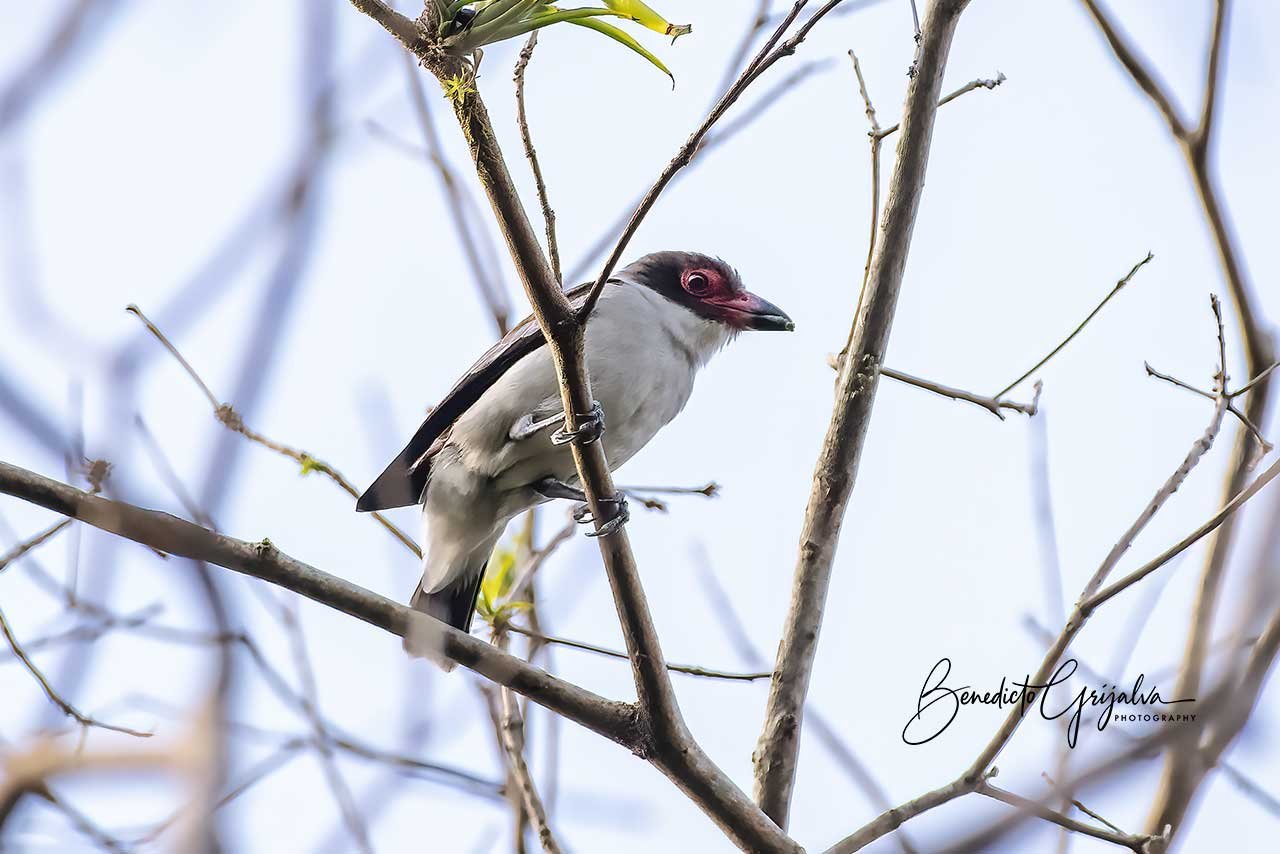
Masked Tityra (Tityra semifasciata)
The Global Big Day
The following day the dawn woke us up with the symphony of birds.
We went to the restaurant area to join the Swarovsky optics international transmission.
We met virtually one day before the global big day to shared a live-broadcast by digiscoping birds from different destinations through Swarovski spotting scopes and our phones.
The bird feeders at the restaurant area and the forest surrounding it were the stage from where it was broadcasted.
There wasn’t much time since several groups share the virtual space.
Still, after waiting, Maynor had the opportunity to bring some White-bellied Chachalacas (Ortalis leucogastra) from a nearby cecropia onto the stage.

White-bellied Chachalaca (Ortalis leucogastra)
After the transmission, we continued enjoying the morning’s movement and of cours ourGuatemala Birding & Photography Tour.
The tanagers were activated; the woodpeckers appeared, including the Golden-fronted Woodpecker (Melanerpes aurifrons) and Golden-olive Woodpecker (Colaptes rubiginosus).
A Lineated Woodpecker (Dryocopus lineatus) flooded the environment with the sound of its hammering on an old tree.
The Yellow-naped Parrot (Amazona auropalliata) was present flying in the surroundings.
Some perched in the distance, we also spotted the Pacific Parakeet (Psittacara strenuus) which is common in this area.
A couple of Crested Caracara (Caracara plancus) were around a Roadside Hawk (Rupornis magnirostris), a Black Hawk-Eagle (Spizaetus tyrannus), and a Common Black Hawk (Buteogallus anthracinus).

Yellow-naped Parrot (Amazona auropalliata)
A pair of Scrub Euphonia (Euphonia affinis) appeared briefly at the feeders.
Then, a couple of Rose-throated Becard (Pachyramphus aglaiae) moved among the heliconias.
Don Paulino, the local guide, came into action, a man over 80 who had been in Patrocinio Reserve for more than a couple of decades.
He asked us to accompany him to the parking area to show us more birds.
By the way, several artificial nests have been installed to support the parrots’ reproduction.

Scrub Euphonia (Euphonia affinis)
Don Paulino showed us a hole and a branch of another bush at an old tree very close by.
He told us that the Collared Aracari (Pteroglossus torquatus) would perch and then enter the nest to feed the chick.
Said and done, the bird appeared and then entered the nest to feed the hatchling.

Collared Aracari (Pteroglossus torquatus)
Altamira Oriole (Icterus gularis), spot-breasted Oriole (Icterus pectoralis), Turquoise-browed Motmot (Eumomota superciliosa), Black-headed Saltator (Saltator atriceps), and White-winged Tanager (Piranga leucoptera) appeared here.
Finally, in a tree in the parking lot, a group of Eastern Kingbirds (Tyrannus tyrannus) perched and caught our attention.
Following this show, we had breakfast and enjoyed the delicious organic coffee produced in the reserve.
After breakfast, we began a walk accompanied by Don Paulino. He was telling us the history of the reserve and the care of the crops.
First, of course, he tried to show us the wildlife of the place.
We spotted White-throated Magpie-Jay (Calocitta formosa), Turquoise-browed Motmot (Eumomota superciliosa), and a Hook-billed Kite (Chondrohierax uncinatus) that flew overhead.
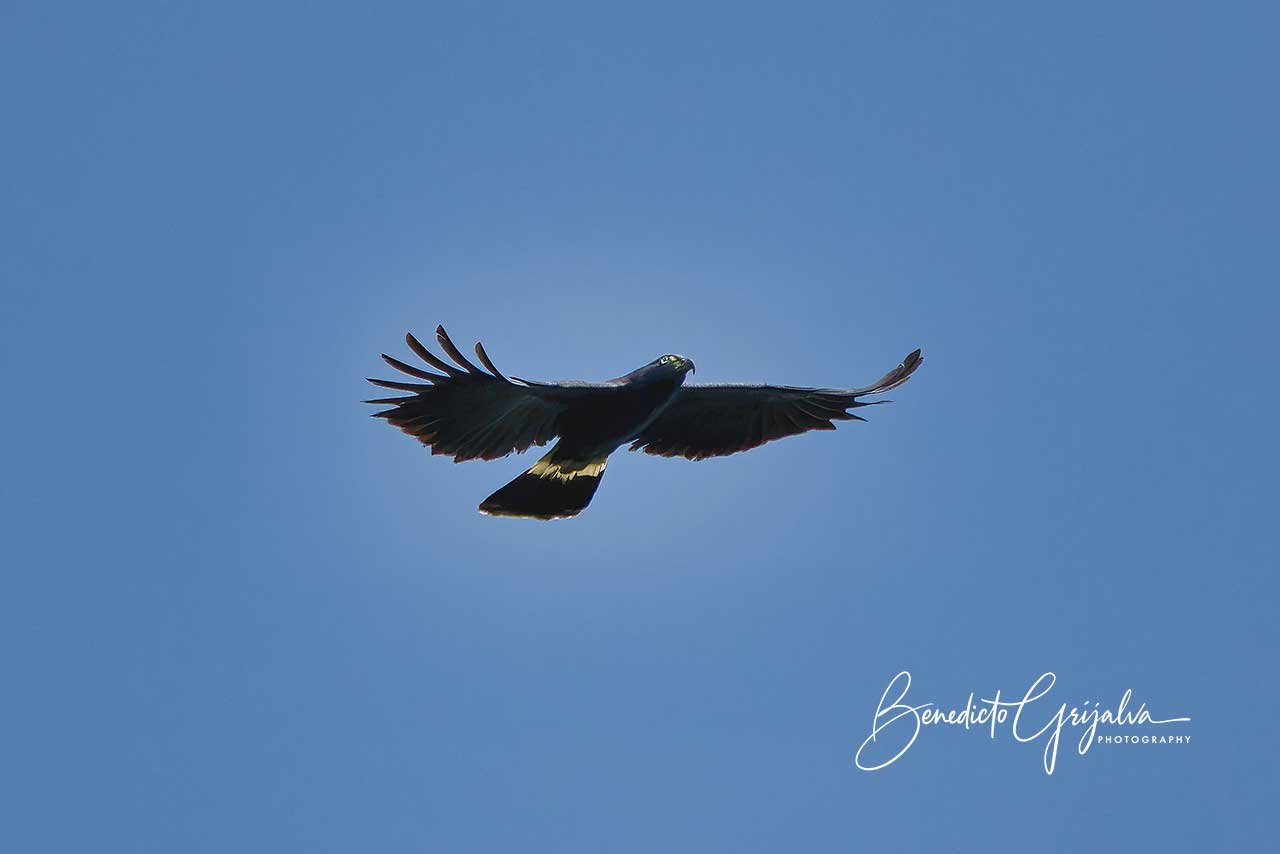
Hook-billed Kite (Chondrohierax uncinatus)

Disturbed Tigerwing Butterfly (Mechanitis polymnia)
A fair amount of skippers, butterflies, dragonflies, and reptiles took up our time while we were trying to photograph them.
On the way back to the restaurant, we crossed the suspension bridge that passes over an area of the stream where it is possible to make a quick-stop and take a refreshing swim..

Dragonfly
Returning to the restaurant for lunch, we noticed that the birds were getting used to our presence.
At the feeder, the White-bellied Chachalaca (Ortalis leucogastra), and the Red-legged Honeycreeper (Cyanerpes cyaneus), the Turquoise-browed Motmot (Eumomota superciliosa) perched in front of us on the zip-line cable.
After lunch and a short rest, we walked along a small path in the lower part of the cabins.
Here, we found a White-throated Thrush (Turdus assimilis), an Ivory-billed Woodcreeper (Xiphorhynchus flavigaster), and a Lesson’s Motmot (Momotus lessonii).

Ivory-billed Woodpecker (Campephilus principalis)
Further on, in the upper part of the bamboo forest, the endemic Guatemalan Tyrannulet (Zimmerius vilissimus) and a migratory Swainson’s Thrush (Catharus ustulatus) recharged energy before its long journey back north.
Wildlife & Nature Night Walk
After dinner, we agreed with Don Paulino to take a short night walk to explore the trails and thus, let us be surprised.
Don Paulino led us to a small pond where we found some frogs. He identified them by their calls.
After a search, we found the Morelet’s tree frog (Agalychnis moreletii), which appeared in the middle of some leaves, which we could admire and photograph, improving our Guatemala Birding & Photography Tour.
We tried to find the glass frog, but unfortunately, it was impossible. So it will remain pending for the near future.

Morelet’s tree frog (Agalychnis moreletii)
Then we headed to a pond without first running into an armadillo that ran me over.
We also found a coral snake and another snake species, that were searching for frogs, just like us, but with different intentions.
Several Morelet’s tree frogs (Agalychnis moreletii) were in the pond, we also found big toad.
This is how we ended a long but productive day at the Patrocinio Reserve.
The following day we headed to the restaurant for our last breakfast and to say goodbye to this beautiful place.
As always, the feeder surrounded by a lot of birds; this time, the Rufous-naped Wrens (Campylorhynchus rufinucha) were in charge of saying goodbye to our team.
The Altamira Oriole (Icterus gularis) showed us that the meeting point was there as we headed to the parking lot to board our vehicle.
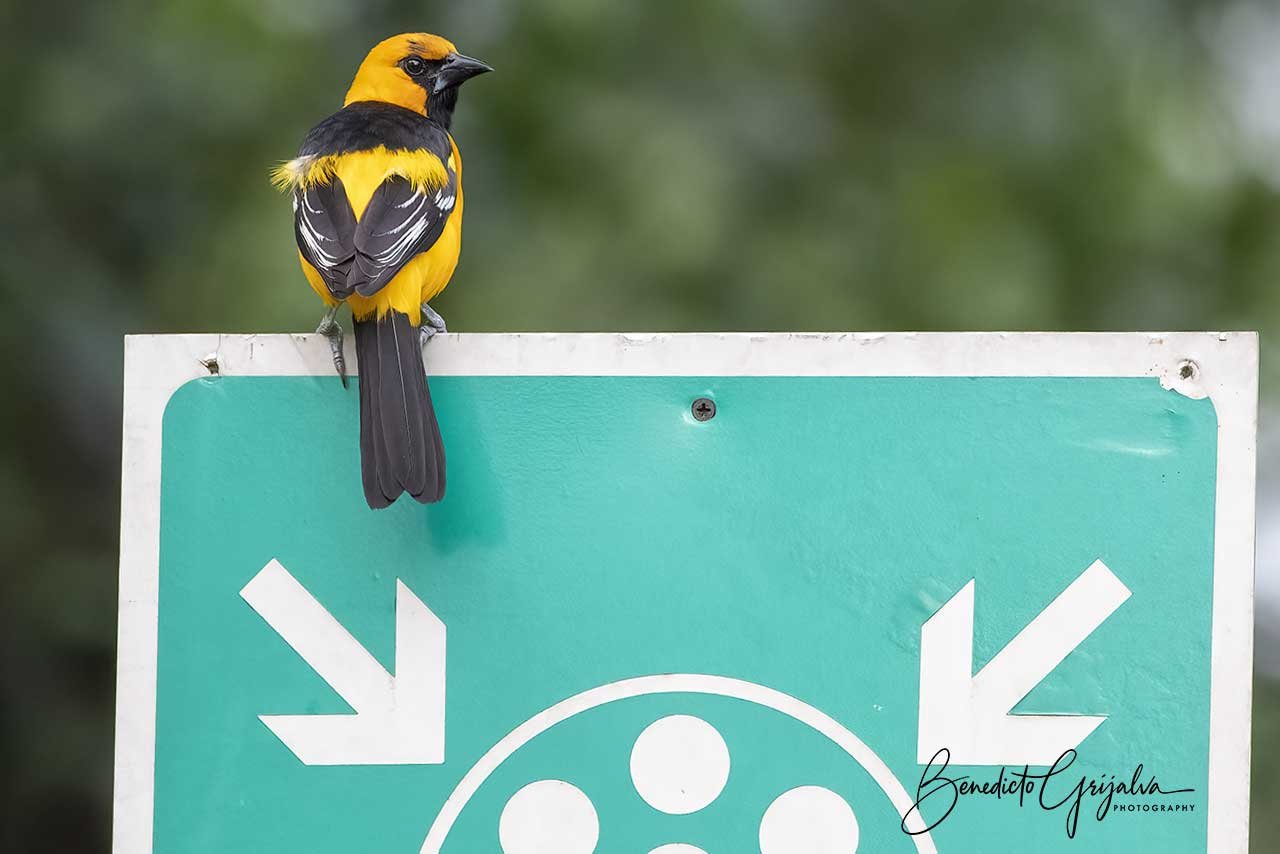
Altamira Oriole (Icterus gularis)
The Patrocinio reserve has a list of approximately 185 species of birds; it is a comfortable place, with good food and friendly people, like most of Guatemala’s country people.
The trails are very well made. The restaurant platform with its feeder is perfect for a Guatemala Birding & Photography Tour.

